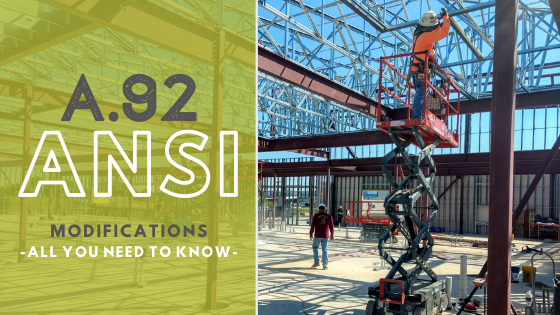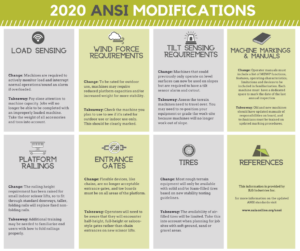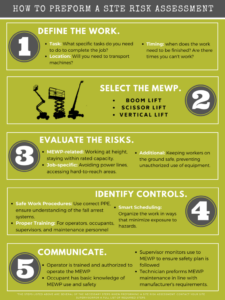
ANSI A.92 Modifications – The Time Is Now
By now, you may have heard of the upcoming changes to ANSI standards for aerial work platforms, now called MEWPs (Mobile Elevating Work Platforms). While we are still unsure of the effective date, we do know changes are coming very soon. While dealers, owners and operators will all feel the impacts of the new standards, we want to focus on how you, the consumer/operator, will be affected.
The new ANSI A92 standard was developed to improve safety and efficiency for MEWP design and use of MEWPs. Within ANSI A92, there are three standards affecting the MEWP user- the A92.20, covering machine design; the A92.22 covering safe use; and the A92.24 covering training.
Machine Design Standards
Under these new standards, MEWPs are classified differently, divided into the following groups:
- Group A for those with platforms that move vertically but stay inside the tipping line.
- Group B for all other MEWPs – typically, boom-type equipment where the platform extends past the tipping line.
Within each of these groups, machines are separated into types:
- Type 1 for those that travel only in the stowed position.
- Type 2 for those that can travel while elevated but controlled from the chassis.
- Type 3 for those that can travel while elevated but controlled from the work platform.
There are also changes to the overall design of the machines.
Safe Use Program
One new requirement that will promote safety when using MEWPs is creating and implementing a “safe use program.” Users are required to develop and implement a safe use program that includes a risk assessment. This risk assessment needs to include guidelines for MEWP supervisors, operators, and occupants. The risk assessment consists of several stages including; work definition, MEWP selection, risk evaluation, rescue planning, and communication. Before a job starts, and periodically throughout a long-term job, the risk assessment must be reviewed to determine if any pieces of the tasks or the work environment have changed, as well as the effect that it could have on the safety of the job.
The user must also develop a written rescue plan that will be carried out in the case of machine breakdown, platform entanglement or fall from the platform. The plan must be put in writing and become part of the company’s training manual. All occupants must receive training that explains the procedures to follow if they fall and await rescue or witness another worker’s fall. This plan must limit the time a properly restrained worker hangs suspended in the air.
Rescue plans can include the following:
- Self-Rescue- by the person involved (using a self-rescue harness)
- Assisted Rescue- by others in the work area (using the ground controls or a second MEWP)
- Technical Rescue- by emergency services (fire department or air rescue)
Training
Dealers, owners and users must train and familiarize, or have proof of training and familiarization, for all employees they allow to operate a MEWP. ANSI will allow qualified operators, who have already received proper training and are qualified to operate other MEWP’s, to self-familiarize on machines they have not yet operated. However, all current operators will need to be trained up to the new standards.
Supervisors of those operating MEWPS must also be properly trained. The user must ensure that all personnel that directly supervise MEWP operators are trained in the following areas:
- Proper MEWP selection- How high?, Outreach or not?, How many people in the platform?, Inside or outside or both?, Doorway access?, Single or double or larger?
- Rules, regulations and standards that apply to MEWPs, including operation, safe use and training
- Potential hazards associated with the use of MEWPS and how to protect against them
- Where manufacturer’s operation manuals should be stored and how they should be used
For more information on these new ANSI standards, please visit Hugg & Hall’s additional articles on this subject at www.hugghall.com/news/category/industrystandards/ or contact a Hugg & Hall salesman.
Below are printable forms to better assist you with these modifications.
Printable Risk Assessment Form
Back to News
Subscribe and unlock cutting-edge equipment insights, trends and tips!
Subscribe

